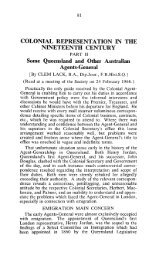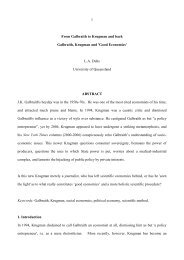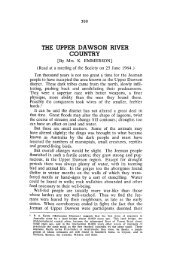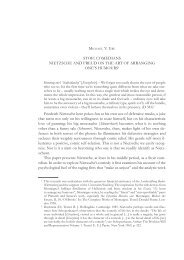Body language: - UQ eSpace - University of Queensland
Body language: - UQ eSpace - University of Queensland
Body language: - UQ eSpace - University of Queensland
You also want an ePaper? Increase the reach of your titles
YUMPU automatically turns print PDFs into web optimized ePapers that Google loves.
Effective Communication for Health Care Pr<strong>of</strong>essionals<br />
1<br />
E Mackenzie B Pharm ∗<br />
CS Farah BDSc, PhD †<br />
NW Savage MDSc, PhD, FFOP RCPA, FICD ‡<br />
Oral Biology and Pathology Research Unit,<br />
The <strong>University</strong> <strong>of</strong> <strong>Queensland</strong>,<br />
Brisbane 4072, <strong>Queensland</strong>, Australia.<br />
Address for correspondence:<br />
Dr CS Farah, Oral Biology & Pathology Research Unit,<br />
The <strong>University</strong> <strong>of</strong> <strong>Queensland</strong>, Brisbane 4072, <strong>Queensland</strong>, Australia<br />
Phone: 07 3365 8840<br />
Facsimile: 07 3365 1109<br />
Email: c.farah@uq.edu.au<br />
Keywords: communication, health pr<strong>of</strong>essional<br />
∗ School <strong>of</strong> Pharmacy, The <strong>University</strong> <strong>of</strong> <strong>Queensland</strong><br />
† Registrar in Oral Medicine and Pathology, and <strong>UQ</strong> Postdoctoral Research Fellow, Oral Biology and Pathology Research<br />
Unit, The <strong>University</strong> <strong>of</strong> <strong>Queensland</strong>.<br />
‡ Reader in Oral Medicine and Pathology, The <strong>University</strong> <strong>of</strong> <strong>Queensland</strong>, and Consultant Oral Pathologist, Royal Brisbane<br />
Hospital, Brisbane, Australia.
Abstract<br />
Effective communication in the dental setting is imperative to the quality <strong>of</strong> health care delivery. Many<br />
patients present at the dental clinic with phobias, fears, anxiety and confusion. The first impression the<br />
clinician makes on the patient can dictate the outcome <strong>of</strong> treatment. Patients are more responsive to<br />
treatment suggestions and ideas if they feel comfortable with the health provider. Good communication<br />
skills can greatly assist the clinician in acquiring an accurate history <strong>of</strong> the presenting complaint,<br />
arriving at a diagnosis, and translating this information into an appropriate treatment plan that the<br />
patient can understand. This can increase patient compliance and satisfaction, and minimise future<br />
potential misunderstandings. This paper highlights techniques health care pr<strong>of</strong>essionals can use to<br />
improve their communication skills.<br />
Introduction<br />
The relationship between health care pr<strong>of</strong>essionals and their patients has been identified as one <strong>of</strong> the<br />
most important elements <strong>of</strong> the health care delivery process. 1-4 This relationship has been cited as a<br />
major factor in patient non-compliance, dissatisfaction with the health care system, and the increase in<br />
malpractice suits. 5-8 Considering the potential problems that can occur due to poor communication<br />
between health care pr<strong>of</strong>essionals and patients, it becomes apparent that good communication skills,<br />
and dealing with patients in a personalised and individualized manner, is essential if successful<br />
pr<strong>of</strong>essional-patient relationships are to be formed. 9-11 Communication can be broken down into three<br />
basic lessons; 1) everything we do is communication, 2) the way we begin our message <strong>of</strong>ten<br />
determines the outcome <strong>of</strong> the interaction, and 3) the way a message is delivered will affect the way the<br />
message is received. 12-14<br />
In this paper, strategies are outlined for effective communication in a health delivery setting (Table 1),<br />
and procedures that maximise the practitioner-patient interaction, and those that distract from it are<br />
highlighted (Table 2). The steps outlined aim to assist the health care provider in ensuring the quality<br />
delivery <strong>of</strong> health services by emphasizing good communication techniques.<br />
Image and first impressions<br />
Approximately 60% <strong>of</strong> first impressions health pr<strong>of</strong>essionals make on their patients are based on<br />
appearance (that is, presentation, dress, and other less controllable factors such as age, height, weight,<br />
and gender). 4,15 This first impression will affect a patient's behaviour and attitude in subsequent<br />
communication, 10,16,17 and so it is vital that clinicians and auxiliary staff create a friendly and<br />
approachable impression, as a significant effort is required to retrieve a patient's confidence once<br />
lost. 10,12,14,15,17 A sincere smile improves the first impression and the entire communication process. 13,17<br />
<strong>Body</strong> <strong>language</strong><br />
<strong>Body</strong> <strong>language</strong> is a vital ingredient in effective communication. 13,18 It is argued that because non-verbal<br />
communication was first used by humankind, people are programmed inherently to respond first and<br />
foremost to non-verbal signals. 19-21 In fact, research indicates that the way people deliver a message<br />
accounts for up to 93% <strong>of</strong> its meaning. 8,13,15 The more control people have over the non-verbal<br />
messages they send, the more control they have over the communication process itself. 13,22 The "right"<br />
body <strong>language</strong> displaying an open receptive approach can assist health providers in obtaining pertinent<br />
patient information that will assist in diagnosis and treatment. 8,13,15,23<br />
The way health pr<strong>of</strong>essionals sit, stand, and walk, conveys much about them to others. 13,23 Upright<br />
posture conveys a sense <strong>of</strong> calm, composure, confidence, and competence. 13,15 Many health care<br />
settings, including the dental <strong>of</strong>fice, evoke considerable fear and uncertainty in patients. 9 To lessen<br />
this, patients become especially alert to information in their environment and the body <strong>language</strong> <strong>of</strong> their<br />
health provider. 9,23 This is why it is extremely important to stay in control <strong>of</strong> non-verbal messages. 9,24<br />
2
3<br />
Habits that give an impression <strong>of</strong> nervousness and agitation, detract from a clinician's message and<br />
authority and send non-verbal messages that can be interpreted negatively by patients. 13,25 Negative<br />
body <strong>language</strong> signals may be interpreted as aggressive, condescending, hostile or defiant, and a closed<br />
body <strong>language</strong>; that is arms and/or legs crossed and not looking at the patient, should be avoided. 13<br />
These signals obstruct effective communication because <strong>of</strong> the strong mind-body link. Negative body<br />
<strong>language</strong> makes gathering relevant information almost impossible (when our body closes up, so do our<br />
ears and mind). 13,23<br />
While at first a concerted effort may be needed to correct any bad body <strong>language</strong> habits, eventually<br />
"doing it right" will come automatically. 13,24 Good body <strong>language</strong> that makes a favourable first<br />
impression and earns a patient's respect includes open body <strong>language</strong>, hand movements that are relaxed<br />
and measured in pace, good posture with head held up, a relaxed jaw, firm eye contact (but not staring),<br />
a neutral facial expression, or one that is appropriate for the situation. 8,13,15,17,23,25,26<br />
The way you sit, stand, and use space<br />
Sitting or standing directly opposite someone; that is, squaring up to them, is sensed as<br />
confrontational. 13 To encourage more open and cooperative communication, sit or stand more at right<br />
angles to each other. 13 This sends messages <strong>of</strong> cooperation and gives both the clinician and the patient<br />
more gazing space in which to look away and think. 13<br />
Height communicates dignity and authority and can place others at a disadvantage. 16 Make sure height<br />
does not intimidate people. 13 If a clinician is taller than average, then moving slightly away from<br />
people provides the opportunity for free communication without intimidation. 13<br />
Be aware <strong>of</strong> the use <strong>of</strong> personal space. 8,23 People are generally "touchy" about their personal space, 13<br />
and trespassing into personal space can cause resentment. It irritates people and induces an<br />
uncomfortable setting. 13 Obviously, since the very nature <strong>of</strong> dental intervention requires invasion <strong>of</strong><br />
personal space, attention should also be placed on minimising this during dental procedures. A general<br />
rule is to stand at arms length, and not to overwhelm the patient while reclining in the dental chair. This<br />
applies to most Australians <strong>of</strong> European descent, however, cultural differences in personal space zones<br />
need to be taken into account. 8,13,15 Generally speaking, when compared with Australians <strong>of</strong> European<br />
descent, Australians from Southern Europe, the Middle East and Asia have smaller personal space<br />
zones, while Northern Europeans, and North Americans have slightly larger zones. 13 Australians from<br />
country areas also tend to have larger personal space zones than people from cities. 13 Overall, a good<br />
habit is to take cues about personal space zones from the patient's demeanour. 13<br />
Reading other peoples body <strong>language</strong><br />
While communicating with a patient, it is essential to be alert for positive and negative signals. 4,13,24,27<br />
This provides an opportunity to review what was said or done to trigger a particular reaction and adjust<br />
one's manner to deliver the desired message leading to the best possible result. 4,13 However, care is<br />
needed in interpreting people’s body <strong>language</strong>. 13,27 Crossed arms can say "I feel threatened by what<br />
you're saying and I am closed to hearing it" or it can say "I’m cold". 13 Therefore, it is important to<br />
think about the context in which the body <strong>language</strong> occurs and to observe clusters <strong>of</strong> signals not<br />
solitary signals. 13,15 It is essential for health providers to accurately interpret a patient’s body <strong>language</strong><br />
and facial expressions. Some patients are reluctant to express their feelings verbally, and their body<br />
<strong>language</strong> and facial expressions will <strong>of</strong>ten reflect their level <strong>of</strong> comprehension and apprehension and<br />
accordingly their receptiveness. 8,9,17,25,27<br />
In this context, negative signals include feet pointed away from the clinician (a person's feet will <strong>of</strong>ten<br />
be pointed in the direction they want to go), tapping feet, body orientated away from the clinician,<br />
rapidly nodding head, rubbing or scratching neck or nose, covering nose or mouth, covering or rubbing
ears, clenched hands, fidgeting, buttoning coat or jacket, tense posture, avoiding eye contact, looking<br />
upward, becoming suddenly quiet and non-communicative. 8,13,23,25<br />
The presence <strong>of</strong> any <strong>of</strong> these signals, particularly in clusters, indicates that what was just said or done<br />
has probably had a negative impact on a patient's willingness to cooperate and be receptive. In such<br />
circumstances the clinician should look for other ways <strong>of</strong> explaining a point <strong>of</strong> view, and concentrate<br />
on listening more carefully to what the patient has to say. These moves may help to redirect the<br />
communication process back onto a positive trail with an easy bi-directional flow <strong>of</strong> information. 4,12,13<br />
Recognition <strong>of</strong> the patient's body <strong>language</strong> and facial expression is immensely helpful for effective<br />
communication. The clinician should be alert to positive signals a patient might be giving. These<br />
generally include nodding thoughtfully, body and feet orientated towards you, stroking chin, good eye<br />
contact, relaxed posture, open body position, open hands, thoughtful uh-hums, and handling <strong>of</strong><br />
documents or materials being discussed during patient education or oral hygiene instructions. 13,23,25,26<br />
The development <strong>of</strong> a cooperative and positive attitude and a willingness to actively contribute by the<br />
patient may present as sitting on the edge <strong>of</strong> the chair, tilted head, moving closer to the clinician,<br />
unbuttoning coat or leaning towards the clinician. 13,26 When favourable signals are noted every effort<br />
should be made to ensure the positive momentum; that is, building on what has been said and how it<br />
has been presented.<br />
Building rapport<br />
When there is rapport with someone, there is synchrony with them, and a feeling <strong>of</strong> sense <strong>of</strong> affinity or<br />
unity. The pr<strong>of</strong>essional relationship lies within a comfortable range which allows communication to<br />
flow easily. Rapport is based on similarity. When two people have rapport their body <strong>language</strong>, energy<br />
levels, and the way they speak are <strong>of</strong>ten the same. This is called matching. We all do this naturally and<br />
unconsciously whenever there is rapport with someone, generally because people like people who are<br />
similar to themselves. 13 The rapport process can be consciously speeded up by actively matching<br />
someone verbally or non-verbally. 13,25 This creates a bond and allows communication to flow more<br />
easily. 4,13<br />
The clinician can match a person's body position (that is mirroring them), and the type and rate <strong>of</strong> their<br />
movements and gestures either partially or precisely. 13,25 Their voice (tone, volume, speed, rhythm, and<br />
pauses), as well as breathing patterns, and the degree <strong>of</strong> seriousness and formality can also be matched<br />
with a usually productive result.<br />
It is worth remembering, that rapport is something achieved with a person and is not a unilateral event<br />
involving only the patient. Do not copy every move a person makes, as their conscious mind should not<br />
notice that you are reactionary rather than spontaneous. Match and mirror sensitively and discreetly.<br />
Adjust verbal and non-verbal communications but do not copy blindly. A technique called leading can<br />
be used to test for rapport. Simply shift position and note whether the other person follows. The more<br />
quickly the other person follows the deeper the rapport is likely to be.<br />
Techniques to show attention and gather information<br />
It is important to make the speaker and the topic at hand the centre <strong>of</strong> attention. 8,13,14 When sitting and<br />
listening, communicate interest and involvement in the conversation by leaning slightly towards the<br />
patient. 8,15,26 However, if the leaning is beyond about 75 degrees it can become domineering and invade<br />
an individual's personal space. 8,13 If used carefully a 60 to 75 degree lean can subtly and tactfully<br />
persuade people to give more information. 13 However, if used insensitively it can easily be a negative<br />
prompt. A 60 to 75 degree lean backwards is also a useful strategy if someone appears to be nervous, is<br />
becoming emotional, or is talking about a difficult personal matter. This reduces some <strong>of</strong> the pressure<br />
4
they might be feeling. However, again there is a fine line, because leaning too far back can signify<br />
disinterest. 8,13<br />
Eye contact<br />
In many cultures including our own, eye contact is an important part <strong>of</strong> communication. 13,15 Eyes are<br />
considered in effect to be the "windows <strong>of</strong> the soul". Too little eye contact can send a strong message<br />
<strong>of</strong> disinterest, while too much eye contact may intimidate others. 8,15 While the right level <strong>of</strong> eye<br />
contact varies between cultures, generally eye contact for about one third <strong>of</strong> the time is comfortable.<br />
The right level <strong>of</strong> eye contact from a speaker indicates sincerity and holds the listener's attention, while<br />
the right level <strong>of</strong> eye contact from a listener indicates that they are paying attention and remain<br />
interested. 8,13,17 Eye contact also encourages the speaker to continue. Increased levels <strong>of</strong> eye contact<br />
can be used to increase pressure and vice versa, but remember that sensitivity is the key. 8,13<br />
Voice<br />
The first few words to open a conversation, and the way they are said, add to a positive first<br />
impression. The voice should be steady, calm, and strong, without being too loud or quiet. Talking too<br />
quickly should be avoided. 18,28 Words should flow easily without awkward hesitations, at a steady even<br />
pace, while emphasizing key words and phrases.<br />
Listening<br />
Listening is essential in establishing and maintaining good relationships, and avoiding<br />
misunderstanding. 18,25,29 Listening should be focused on understanding and not with the intent <strong>of</strong><br />
replying. 13 This requires one to temporarily set aside personal thoughts, expectations, biases, and<br />
desires. 13,18,29 There are many reasons why people do not listen properly. An individual may consider<br />
he has something better to say, or pre-empt what the other person will say. There may be too many<br />
distractions including tiredness or focusing on one's own thoughts rather than listening properly. 13,18,30<br />
Sometimes the speaker or their message may not be particularly palatable and so is filtered to only hear<br />
selected extracts and reject the speaker's viewpoint. At other times conclusions may be reached too<br />
rapidly without due preparation <strong>of</strong> replies and yet giving a false feeling <strong>of</strong> involvement and<br />
control. 13,18,25,30<br />
The right body <strong>language</strong> shows that the speaker has the listener's attention and encourages the<br />
comfortable release <strong>of</strong> information. 18 Active listening can be shown by maintaining open body<br />
<strong>language</strong> where arms and legs are uncrossed, nodding, saying uh-huh, I see, mmm, or repeating a key<br />
word or phrase, orientating the body toward the speaker, maintaining eye contact, and leaning slightly<br />
forward. 8,13,25,26 It is important to remove barriers or distractions that inhibit focusing on the speaker. 12<br />
Listening techniques<br />
Reflective listening brings the greatest rewards in terms <strong>of</strong> information, understanding, and results. 8 A<br />
speaker's message is <strong>of</strong>ten imprecise, but reflective listening encourages speakers to develop their<br />
thoughts and clarify what has been said, and provide the opportunity to add further information. 8,9,31<br />
This can be assisted by mentally summarising the communication and restating the speaker’s main<br />
points. 8,9 However, ensure the statement is summarised in a tentative, not dogmatic way, 8,9,13 and that<br />
attention is paid to the speaker’s reactive body <strong>language</strong>, facial expressions and gestures. 15,17,18<br />
When several points are made, summarise the one that will keep the conversation going in the desired<br />
direction. When several emotions are expressed, reflect the final one, as it is generally the most<br />
accurate. Remain neutral and show neither approval nor disapproval. Keep restatements short to<br />
maintain the focus on the speaker. Use thoughtful silences. Reflective listening responses are<br />
5
statements not questions and they should encourage more information and elaboration, not a yes/no<br />
answer. 8,9,12,13,25 Begin restatements with "You sound", "You seem", "Your idea is", or "You must feel<br />
as though".<br />
Reflective listening is useful because it draws out more information and shows active listening whilst<br />
encouraging the speaker to continue. It also prevents or minimises misunderstandings, shows support<br />
for and acceptance <strong>of</strong> the speaker, and can diffuse emotion and calm down an upset or emotional<br />
patient. Reflective listening can increase a patient's confidence in the care provided by health<br />
pr<strong>of</strong>essionals. 8,9,13,17<br />
Questioning to gather information<br />
The ability to ask appropriate questions is one <strong>of</strong> the most important techniques for productive<br />
interviews and consultations. 8,9,15 Health pr<strong>of</strong>essionals should avoid interrogating patients. 8,9 It is<br />
important that both participants have equal opportunity to request, receive, and disclose information. 12<br />
There are four basic steps in gathering quality information: 8,9,13,17,18,32<br />
1. Explore by asking open questions (for example "What problems have you had?")<br />
2. Use affirmative listening techniques (see above)<br />
3. Give a reflective listening response (see above)<br />
Pause and allow the speaker time to respond.<br />
Try to ensure the conversation contains only short silences, as long pauses can become uncomfortable<br />
and create a sense <strong>of</strong> loss <strong>of</strong> direction in interviews. Closed questions can also be used to elicit a quick<br />
answer (for example "Have you used this product before?"). They are efficient and provide a health<br />
pr<strong>of</strong>essional with valuable information. 9<br />
Another technique that is helpful while questioning patients is the funnelling technique which allows<br />
direction and focusing <strong>of</strong> ideas on a specific topic. 15 It involves directing questions to a particular<br />
subject area, by initially asking background open questions to gather basic information, and then asking<br />
specific closed questions to obtain more detailed information and clarify points. 15 It is beneficial to use<br />
reflective listening while focusing on the open questions to ensure that the information being obtained<br />
is accurate. 8,15<br />
6<br />
Tips on questioning patients<br />
Avoid coercive and leading questions. 10,13 These questions imply the answer being sought, for example<br />
"You will not have problems with that, will you?". Do not answer questions for the other person, or fill<br />
in thoughtful silences with nervous chatter or unrelated conversation.<br />
It is also important to avoid medical jargon when speaking with patients as they may not understand<br />
important advice, and may feel reluctant to ask questions they perceive as making them look<br />
foolish. 15,17,33,34<br />
Use "I" rather than "You" statements. 15 "You" statements are negative and can sound like accusations,<br />
while "I" statements place the responsibility for the observation on the speaker. For example: "You<br />
appear to be taking a lot <strong>of</strong> those lately", as opposed to "I have noticed that you appear to be taking a<br />
lot <strong>of</strong> those lately".<br />
Delivering information effectively<br />
The key to effective communication is to use short sentences. 12,28 Long and consequently rambling<br />
sentences confuse patients because they are unable to remember where the sentence started and what its
original purpose was. 28 Words should also be chosen carefully. Do not use words that subliminally<br />
detract from your credibility, for example "I honestly believe that" or "I am not exactly sure <strong>of</strong> this but"<br />
or "I think I once read". 28 Project an air <strong>of</strong> confidence through the choice <strong>of</strong> words and do not apologise<br />
for or justify the concepts put forward. 28 A confident voice also evokes more compliance from others<br />
and is more persuasive. 16 Patients tend to recall information given at the beginning and the end <strong>of</strong><br />
discussions. Therefore, set priorities when counselling a patient, as the more that is said, the more likely<br />
it is to be forgotten. 12 Increased compliance can also be gained by using repetition to draw attention to<br />
the most important points in the communication. 12,17,29 Many patients are very appreciative <strong>of</strong> careful<br />
written instructions, and this certainly encourages compliance.<br />
Speakers attempting to be more persuasive should make more eye contact, gesture more, use<br />
affirmative nods, be more facially expressive, not fidget, and lean backward less. 16<br />
In summary, communication involves more than just words. 13,14 It includes active participation, use <strong>of</strong><br />
facial and vocal expressions, body posture, gestures, and even appearance to enhance effective patient<br />
communication. 14,15 Communication is an important life skill. It is particularly important for health care<br />
providers in dealing with patients and other health care workers. 8,15,18 Good communication can<br />
effectively contribute to the delivery <strong>of</strong> quality health care services, while incomplete communication<br />
may result in potential harm to the patient. Good communication is not easy and needs practice until it<br />
becomes a reflex response. Possessing good communication skills is an achievable goal that will<br />
enhance clinical practice immensely. 8,10,15,25<br />
7
Table 1. Factors that contribute to effective patient-health care provider communication.<br />
8<br />
Image and first impressions affect a patient's attitude and behaviour towards the health care provider<br />
<strong>Body</strong> <strong>language</strong> and non-verbal communication messages convey information about you to your patient<br />
The way you sit, stand, and use space can be used to enhance the communication process<br />
Try to read the patient's body <strong>language</strong> and facial expressions and respond accordingly<br />
Building rapport with a patient provides a sense <strong>of</strong> affinity and unity based on similarity<br />
Making the patient and the topic at hand, the centre <strong>of</strong> attention<br />
The right level <strong>of</strong> eye contact from the health pr<strong>of</strong>essional indicates sincerity and holds the patient's<br />
attention<br />
Voice adds to a positive first impression<br />
Listening to understand, not listening with the intent to reply<br />
Asking appropriate questions and avoiding interrogating the patient<br />
Delivering information effectively
Table 2. Techniques used to enhance effective patient-health care provider communication.<br />
9<br />
A sincere smile improves the first impression<br />
Upright posture conveys a sense <strong>of</strong> calm, composure, confidence, and competence, while fidgeting<br />
gives an impression <strong>of</strong> constant agitation and nervousness<br />
Sitting or standing at right angles to the patient encourages open and cooperative communication<br />
Respect the patient's personal space and generally stand or sit at arms length<br />
Use matching techniques sensitively to build rapport; this can include body position, type and rate <strong>of</strong><br />
gestures, voice, and breathing pattern<br />
When listening to a patient, leaning forward slightly will encourage the provision <strong>of</strong> more information,<br />
while leaning backwards will ease an emotional nervous patient<br />
Too little eye contact can indicate an uninterested listener, while too much eye contact can intimidate<br />
others<br />
Voice should be steady, calm, and strong, without being too loud or quiet, and sentences should not be<br />
rushed<br />
Show active listening by maintaining open body <strong>language</strong> (nodding, good eye contact), and use<br />
reflective listening techniques<br />
Gather information by asking open questions using affirmative and reflective listening, and allow the<br />
patient time to respond<br />
Avoid coercive or leading questions as these imply a specific answer is expected<br />
Avoid medical jargon lest the patient is alienated through misunderstanding<br />
Use short sentences to convey a message, and deliver it with a confident voice to increase compliance<br />
Deliver pertinent information only, and use repetition to draw attention to the important points<br />
Provide written instructions where any detail is required
References<br />
10<br />
1. Rodin J, Janis I. The social power <strong>of</strong> health-care practitioners as agents <strong>of</strong> change. J Soc Issues<br />
1979;35:60-81.<br />
2. Ruben BD. The health caregiver-patient relationship: pathology, etiology, treatment. In: Ray<br />
EB, Donohew L, eds. Communication and health: systems and applications. Hillsdale: Lawrence<br />
Erlbaum, 1990:51-68.<br />
3. Thompson TL. Patient healthcare: issues <strong>of</strong> interpersonal communication. In: Ray EB,<br />
Donohew L, eds. Communication and health: systems and applications. Hillsdale: Lawrence Erlbaum,<br />
1990:27-50.<br />
4. Hargie ODW, Morrow NC, Woodman C. Pharmacist’s evaluation <strong>of</strong> key communication skills<br />
in practice. Patient Educ Couns 2000;39:61-70.<br />
5. Stone G. Patient compliance and the role <strong>of</strong> the expert. J Soc Issues 1979;35:34-59.<br />
6. DiMatteo M. A social psychological analysis <strong>of</strong> physician-patient rapport: toward a science <strong>of</strong><br />
the art <strong>of</strong> medicine. J Soc Issues 1979;35:12-33.<br />
7. Taylor S. Hospital patient behaviour: reactance, helplessness or control? J Soc Issues<br />
1979;35:156-184.<br />
8. Gordon T, Edwards WS. Making the patient your partner: communication skills for doctors and<br />
other caregivers. Westport: Greenwood Publishing Group Inc, 1995.<br />
9. Northouse PG, Northouse LL. Health communication: strategies for health pr<strong>of</strong>essionals. 2nd<br />
edn. Norwalk: Appleton & Lange, 1992.<br />
10. Landis NT. Lessons from medicine and nursing for pharmacist-patient communication. Am J<br />
Health Syst Pharm 1996;53:1306-1314.<br />
11. Ley P. Communicating with patients: improving communication, satisfaction and compliance.<br />
London: Chapman and Hall, 1988.<br />
12. Verheyen F, Muhlbauer K, Schulz M. Patient education – how to communicate with patients.<br />
Int Pharm J 1998;12:118-120.<br />
13. Cole K. Crystal clear communication: skills for understanding and being understood. 2nd edn.<br />
French's Forest: Pearson Education Australia, 2000.<br />
14. Van Dulmen S. The key to good healthcare communication. Patient Educ Couns 2002;46:233-<br />
234.<br />
15. Winfield AJ, Richards RME. Pharmaceutical practice. 2nd edn. Edinburgh: Churchill<br />
Livingstone, 1998.<br />
16. Burgoon JK, Buller DB, Woodall WG. Nonverbal communication: the unspoken dialogue. 2nd<br />
edn. New York: McGraw-Hill, 1996.<br />
17. Nyman KC. Successful consulting: a practical introduction to consulting skills in general<br />
practice. Victoria: The Royal Australian College <strong>of</strong> General Practitioners, 1996.<br />
18. Metcalf C. Stoma care: exploring the value <strong>of</strong> effective listening. Br J Nurs 1998;7:311-315.<br />
19. Dew D, Jensen PJ. Phonetic processing: the dynamics <strong>of</strong> speech. Columbus: Merrill, 1977.<br />
20. McBride G. Interactions and the control <strong>of</strong> behaviour. In: Kendon A, Harris RM, Key MR, eds.<br />
Organisation <strong>of</strong> behaviour in face to face interaction. The Hague: Mouton, 1975: 415-425.<br />
21. McNeill D. The acquisition <strong>of</strong> <strong>language</strong>: the study <strong>of</strong> developmental psycholinguistics. New<br />
York: Harper and Row, 1970.<br />
22. Argyle M. Bodily communication. 2nd edn. London: Methuen, 1988.<br />
23. Robinson JD. Getting down to business: talk, gaze, and body orientation during openings <strong>of</strong><br />
doctor-patient consultations. Hum Commun Res 1998;25:97-123.<br />
24. De Roten Y, Darwish J, Stern DJ, Fivaz-Depeursinge E, Carboz-Warnery A. Nonverbal<br />
communication and alliance in therapy: the body formation coding system. J Clin Psychol<br />
1999;55:425-438.
25. Kacperek L. Non-verbal communication: the importance <strong>of</strong> listening. Br J Nurs 1997;6:275-<br />
279.<br />
26. Egan G. The skilled helper. 4th edn. California: Brooks/Cole Pacific Grove, 1990.<br />
27. Davis P. Non-verbal communication with patients. Br J Nurs 1994; 3:220-223.<br />
28. Hooke J, Philips J. Getting your message across: the seven steps to communicating successfully<br />
in every situation. East Roseville: Simon & Schuster Australia, 1996.<br />
29. Vermeire E, Hearnshaw H, Van-Royen P, Denekens J. Patient adherence to treatment: three<br />
decades <strong>of</strong> research; a comprehensive review. J Clin Pharm Ther 2001;26:331-342.<br />
30. Dickson D, Hargie O, Morrow N. Communication skills training for health pr<strong>of</strong>essionals.<br />
London: Chapman and Hall, 1989.<br />
31. Benjamin A. The helping interview. 3rd edn. Boston: Houghton Mifflin Company, 1981.<br />
32. Lee AJ, Borham A, Korman NE, Keeney BE, Mock ED. Staff development in pharmacistconducted<br />
patient education and counselling. Am J Health Syst Pharm 1998;55:1792-1798.<br />
33. DiMatteo M, Friedman H. Social psychology and medicine. Cambridge: Oelgeschlager, Gunn<br />
and Hain, 1982.<br />
34. Sharf BF. The physician’s guide to better communication. Glenview: Scott Foresman and<br />
Company, 1984.<br />
11


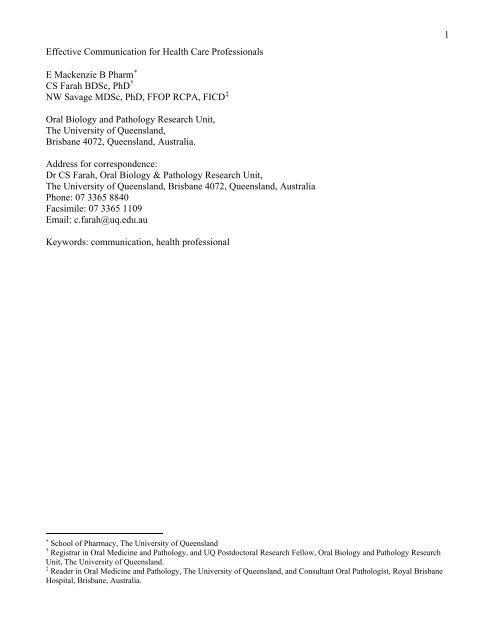


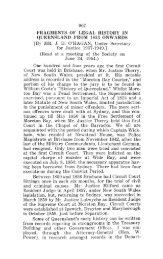


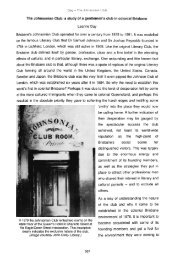
![Kanaka Labour in Queensland, [ises-mi] - UQ eSpace](https://img.yumpu.com/21925421/1/163x260/kanaka-labour-in-queensland-ises-mi-uq-espace.jpg?quality=85)

